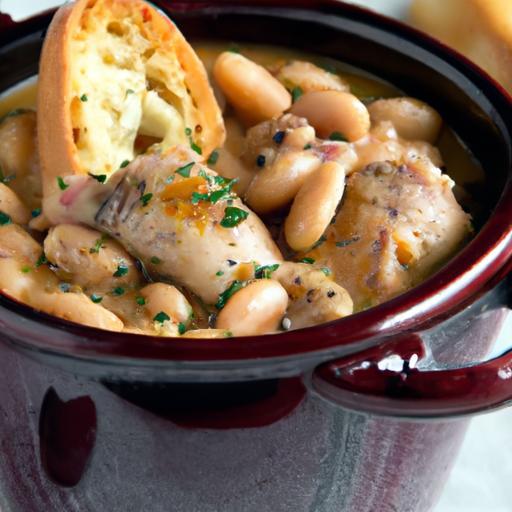Nestled deep in the culinary heart of southwestern France, cassoulet stands as a testament to rustic comfort and timeless tradition. This hearty, slow-cooked stew, brimming with tender white beans, rich meats, and aromatic herbs, is more than just a dish-it’s a story simmered through centuries. In “Cassoulet Uncovered: A Hearty French Classic Explained,” we’ll peel back the layers of history, technique, and regional pride that make cassoulet a beloved emblem of French gastronomy. Prepare to embark on a flavorful journey that uncovers the secrets behind this iconic casserole, revealing why it continues to warm tables and hearts around the world.
Cassoulet Uncovered: this hearty French classic is much more than a rustic stew; it is a soulful expression of French countryside tradition and culinary artistry. Originating from the Languedoc region, cassoulet is a slow-cooked symphony of tender white beans, rich meats, and aromatic herbs that captures the essence of comfort food. Each region-whether Toulouse, Carcassonne, or Castelnaudary-offers its own cherished variation, reflecting local ingredients and ancestral methods that elevate the dish from humble origins to an iconic French staple.
The Art of Crafting the Perfect Cassoulet: Essential Ingredients and Cooking Techniques
Mastering the perfect cassoulet requires patience and respect for time-honored techniques. The foundation is slow-simmered white beans, traditionally Tarbais beans, prized for their creamy texture and ability to absorb deep flavors. The meat medley typically includes pork shoulder, duck confit, and sometimes garlic sausage, each adding savory complexity and a luscious mouthfeel. Classic herbs like thyme and bay leaves infuse an earthy aroma that ties every element seamlessly.
Prep and Cook Time
- Preparation: 45 minutes (plus overnight soaking of beans)
- Cooking: 3-4 hours (slow simmer and oven baking)
Yield
- 6 hearty servings
Difficulty Level
- Advanced – patience and careful layering of flavors required
Ingredients
- 500g dried Tarbais or Great Northern beans, soaked overnight
- 400g pork shoulder, cut into large chunks
- 4 duck confit legs
- 300g garlic sausage (such as Toulouse sausage), sliced
- 1 large onion, finely chopped
- 2 carrots, diced
- 4 cloves garlic, minced
- 1 bouquet garni (thyme, bay leaves, parsley stems)
- 1 can (400g) crushed tomatoes
- 4 cups chicken or vegetable stock
- 100g pork rind or rind from confit (optional but traditional, cut into strips)
- Salt and freshly ground black pepper, to taste
- 2 tbsp duck fat or olive oil
- Fresh parsley for garnish
Instructions
- Prepare the beans: Drain soaked beans and place in a large pot. Cover with fresh water, add 1 chopped carrot and bouquet garni. Bring to a gentle boil then simmer for 1 to 1.5 hours until beans are tender but not mushy. Drain and discard herb and carrot.
- Brown the pork shoulder: In a heavy skillet, heat 1 tbsp duck fat over medium heat. Sear pork chunks until evenly browned, about 5 minutes. Remove and set aside.
- Sauté vegetables: In same skillet, add remaining duck fat, sauté onion, carrots, and garlic until golden and fragrant, about 7 minutes.
- Combine meats and beans: In a large heavy casserole or traditional cassole pot, layer half the beans, browned pork, sausages, duck confit legs, sautéed vegetables, pork rind strips (if using), and remaining beans on top.
- Add liquids and season: Pour stock and crushed tomatoes over layers. Adjust salt and pepper generously. Tuck bouquet garni in the pot.
- Simmer gently: Cover partially and cook on low heat for 2-3 hours. Check occasionally; add a splash of stock if drying out. The mixture should bubble languidly.
- Finish with a crust: Preheat oven to 180°C (350°F). Press down beans and meats slightly, then allow a crust to form by baking uncovered for 30-40 minutes. Every 10-15 minutes, break crust and push it down to meld flavors further.
- Rest and serve: Let cassoulet rest 15 minutes before serving to deepen flavors.
Chef’s Notes for Cassoulet Success
- Bean choice is key: Tarbais beans are preferred, but Great Northern or Cannellini beans are good substitutes.
- Layer flavors deliberately: The slow build of meats and beans is what defines cassoulet’s depth.
- Make ahead: Cassoulet tastes even better the next day; reheat slowly in the oven.
- Crunchy crust ritual: Breaking the crust multiple times during baking adds authentic texture and prevents dryness.
Serving Suggestions
Present cassoulet in rustic earthenware bowls, garnished with a sprinkle of chopped fresh parsley and a few thyme sprigs for aroma. Serve alongside a crisp green salad dressed lightly with mustard vinaigrette and crusty French bread to soak up the luscious juices. To elevate the authentic French experience, opt for a robust red wine such as Cahors or a fruity Minervois. The warmth and richness of this dish make it perfect for chilly evenings and festive gatherings alike.
| Nutritional Element | Per Serving |
|---|---|
| Calories | 680 kcal |
| Protein | 45g |
| Carbohydrates | 40g |
| Fat | 33g |

Explore more traditional French recipes and cooking insights on our French Country Cooking page. For deeper historical context and ingredient sourcing tips, visit Encyclopaedia Britannica’s cassoulet entry.
Q&A
Q&A: Cassoulet Uncovered – A Hearty French Classic Explained
Q1: What exactly is cassoulet?
A1: Cassoulet is a rustic, slow-cooked French casserole, traditionally woven with white beans, savory meats like duck confit, pork sausages, and sometimes lamb. It’s a dish that embodies comfort, heritage, and the art of patience in French cuisine.
Q2: Where does cassoulet originate from?
A2: Hailing from the south of France, particularly the Languedoc region, cassoulet’s roots lie deep in medieval times. It’s named after the earthenware pot, the cassole, used to perfect its slow simmer and deep flavor.
Q3: What makes cassoulet so special compared to other stews?
A3: Cassoulet’s magic is in its meticulous layering of flavors and textures. The creamy white beans absorb the rich, meaty juices, while the crust that forms on top during baking adds a sublime crunch – a contrast that keeps food lovers coming back.
Q4: Can cassoulet be made with vegetarian or vegan ingredients?
A4: Absolutely! While traditional cassoulet brims with meat, creative cooks have crafted versions with mushrooms, hearty root vegetables, smoked tofu, or seitan to replicate that robust umami flavor, proving this classic can embrace modern palettes.
Q5: How long does it typically take to make cassoulet?
A5: True cassoulet is a labor of love. The dish requires several hours-often 4 to 6-of slow cooking, with careful attention to repetition of browning and baking to develop complexity. It’s a perfect weekend project for those who savor slow food.
Q6: What wines pair best with cassoulet?
A6: Cassoulet’s rich, meaty profile pairs beautifully with hearty, medium to full-bodied reds from southwestern France, such as a robust Cahors or a spicy Madiran. These wines cut through the richness while highlighting the dish’s earthy notes.
Q7: Why is cassoulet considered a symbol of French culinary tradition?
A7: Cassoulet symbolizes the soul of French country cooking – humble ingredients transformed through time-honored techniques into a dish that celebrates regional pride, communal eating, and the timeless joy of shared meals.
Q8: Where can one taste an authentic cassoulet?
A8: For an authentic experience, visit towns like Castelnaudary, Toulouse, or Carcassonne, where cassoulet is both culinary pride and communal ritual. Many local bistros still serve it the traditional way, honoring recipes passed down through generations.
Discovering cassoulet is like uncovering a delicious story simmered over centuries – a hearty, fragrant tale that welcomes all who savor its warmth and history. Bon appétit!
Concluding Remarks
As the last spoonful of cassoulet warms your soul, it’s clear that this hearty French classic is more than just a meal-it’s a celebration of tradition, patience, and rich regional flavors. From its humble rustic origins to its status as a beloved symbol of comfort food, cassoulet invites us to slow down, savor each bite, and appreciate the art of slow-cooking at its finest. Whether you’re a seasoned gourmand or a curious newcomer, uncovering the layers of this dish is a journey worth taking-a delicious reminder that some stories, much like cassoulet itself, only get better with time.


